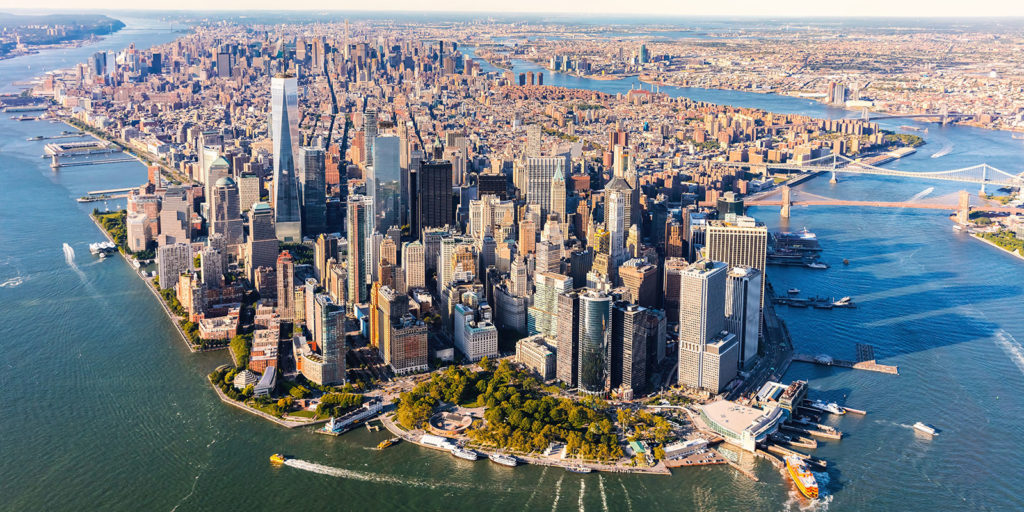Upper, Uptown, Midtown, Downtown
New Yorkers generally divide Manhattan into four sections:
220th St
Upper Manhattan
110th St | 96th St
Uptown
59th St
Midtown
14th St
Downtown
Battery
East | West
Fifth Avenue is Manhattan’s spinal column. It divides cross streets into East | West. Pay close attention to “E” and “W” on addresses or you may end up on the wrong side of town like we did on our first day at work many years ago.
Downtown, Broadway is Manhattan’s spinal column. The old Lenape trail cuts diagonally across the street grid from the site of the old village in Inwood up north, down to the old trading post where the National Museum of the American Indian is now on the Battery.
Manhattan is built on Native American Lenape land. It is the heart of the city and what most people mean when they say, “New York City” or “The City.”
Manhattan is Latin from its Beginnings
What is now New York City was the land of the Indigenous Lenape Delaware people. We called the island Manahatta, the “land of many hills.” The hills were mostly flattened out by development, but there are still some in Upper Manhattan.
The old Lenape village was in Inwood at Manhattan’s northern tip. Naturally it is the most beautiful and quiet spot in Manhattan. There are “Indian Caves” up in the hills.
The Lenape trading post was at Manhattan’s southern tip. Broadway was the trail between them. It became the Alexander Hamilton U.S. Customs House. It is now the National Museum of the American Indian which is part of the Smithsonian.
Most of us live in Oklahoma, but we are still around in parts of Delaware, New Jersey and Canada.
Manhattan’s First Immigrant was Dominican
Juan Rodriguez (Jan Rodrigues in Dutch or João Rodrigues in Portuguese) was Manahatta’s first immigrant. He was Portuguese-African from Santo Domingo in what is now the Dominican Republic. He left a ship because he didn’t want to go to the Netherlands and settled at the Lenape trading post.
Today we (Dominicans) are one of New York City’s largest Latin communities.
New Amsterdam was founded when the Dutch broke away from the Spanish Netherlands
The original Dutch settlement below Wall Street was founded in 1624. It was part of a burst of Dutch energy that came after breaking away from the Spanish Netherlands.
New Amsterdam wasn’t Latin, but the energy that created it was in direct opposition to the Latin patriarchy of Catholic popes and Spanish kings.
Authoritarianism consumes everything and destroys individual initiative. In contrast, the Dutch did business with everyone and founded the idea of the corporation. That was the idea that people can work together on a common goal and share the fruits of their labors. Corporations can get out of hand, but working together for a common benefit is the founding idea of New York City and democracy in the United States.
We are still here in New York City’s commercial energy.
NYC first Jewish community was Sephardic (Spanish & Portuguese)
New York City’s first Jewish community was a group of twenty-three Sephardics (Spanish & Portuguese Jews). Fleeing the Spanish Inquisition in Brazil, we arrived in what was Dutch New Amsterdam in 1654. Director General Peter Stuyvesant tried to deport us, but we appealed to the leaders of the Dutch West India Company. Because of us, New York is an open city.
We are still here as Congregation Shearith Israel in the Upper West Side.
Wall Street was built by People Enslaved by Europeans
Wall Street was built by enslaved humans to keep out the Indigenous Lenape. You could buy and sell humans at The Wall.
There was once a slave market at the corner of Wall Street and Pearl Street. It was the second biggest slave market in our country, after Charleston, South Carolina. Most of New York City’s enslaved peoples were brought from Cuba to Pier 17 which is now the South Street Seaport.
We are still here. Yale University historian Robert Farris Thompson has said, “New York is the secret African city.”
The Capital of the Latin World
Today New York City is the capital of the world, and the Latin world. Every people from every where is here. It’s not perfect, but we get along pretty well. By living, working and loving together, we have lost our fear of “the other” and found in its place our common humanity.
When you’re here, you’re a New Yorker. Ya.
This is an aerial view of Manhattan from New York Harbor. New York City is what it is today because it is on the water which was the superhighway of old. New York Harbor could safely hold a thousand ships.
This view shows Manhattan’s two business districts of skyscrapers. The Downtown Financial District, whose tallest building is the World Trade Center, is in the foreground. The skyscrapers in the background are Midtown.
The Hudson River is on the left with New Jersey on the other side. Far up the Hudson, you can see the George Washington Bridge (I-95). That is near the northern tip of Manhattan, but not quite.
The Bronx is along the horizon.
The East River is on the right. The thin stretch of water along the horizon is Long Island Sound. The East River bridges are the Brooklyn Bridge, Manhattan Bridge and Williamsburg Bridge. They all lead to Brooklyn.
Further up the East River, the tall buildings on the eastern shore are Long Island City, the beginning of Queens. Still further up, the island with a bridge on it is Roosevelt Island and the Queensboro or 59th St Bridge. The Simon and Garfunkel song, “59th St Bridge Song” or “Feelin’ Groovy” is about walking across it to Manhattan.
Staten Island is behind, but not in the picture. You can see the orange Staten Island Ferry docking in the very foreground.

